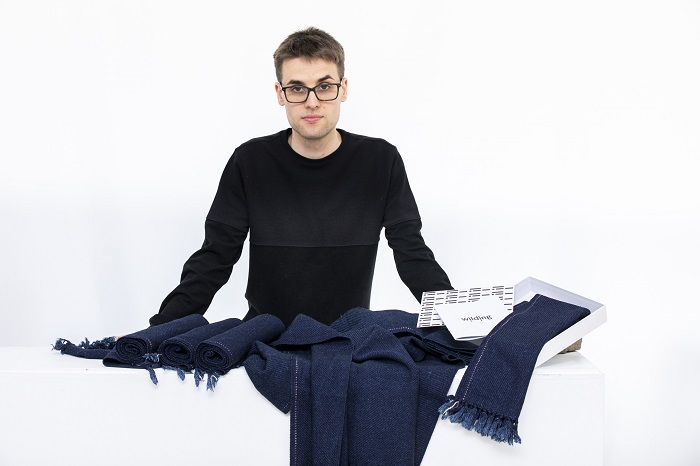
An ancient fabric dye favoured by Japanese Samurai warriors for its natural antibacterial qualitieshas inspired a textile designer to create a new collection of high fashion scarves.
Talented designer Gethin Ceidiog Hughes, 27, from Denbigh, in North Wales, has launched the Japanese denim scarves using indigo dye and techniques mastered by traditional weavers – and uses Halen Môn (Anglesey Sea Salt) mixed with white distilled vinegar as a finishing agent.
The new range is the result of six months of painstaking research and experimentation.
The launch was timed to coincide with the Rugby World Cup in Japan and to celebrate the growing links between the two countries.
Gethin recently embarked on a residency at Ruthin Craft Centre which was made possible by a £5,000 grant from Arts Council of Wales and he hopes to stage his first solo exhibition there in the New Year.
Indigo is among the oldest dyes to be used for textile dyeing and printing in the world and dates back at least 6,000 years to Peru.
The characteristic blue of the dye comes from the leaves of the Japanese Indigo plant, Persicaria tinctori, which has natural antibacterial, anti-odour and flame retardant properties.
Samurai soldiers wore original indigo-dyed garments under their armour as a way to protect their bodies from infection and to help cleanse wounds.
Gethin discovered that Anglesey Sea Salt from Halen Môn was the perfect “finishing agent”, helping to lock the colour into the cloth.
The scarves will be available to buy from stockists and online under Gethin’s brand Wilding, which is his mother’s middle name.
“It has been a real labour of love,” said Gethin.
“Japan is known for making the best silk and denim in the world. Nothing else can compete with the quality. It has taken a lot of experimentation and research to create something that is authentic and I’m really excited with the results.
“Anglesey Sea Salt, which is available on my doorstep, is used by countless Michelin chefs – even former US President Barack Obama apparently enjoys the Welsh delicacy. Now it’s being used to finish denim in North Wales and it works really well.”
Gethin studied Product Design at the famous Cardiff School of Art and Design before going on to complete an MA in Art and Design.
Upon leaving university, he won a prestigious placement as part of the Proof Scholarship scheme at the Regional Print Centre, which is part of Coleg Cambria in Wrexham.
While there, he spent a summer experimenting with various techniques alongside prominent artists and printmakers and it was this work which won him Wales’ most coveted printmaking accolade – the Eirian Llwyd Memorial Award honouring Welsh artists who have shown outstanding dedication and creative talent in their field of printmaking.
Eirian Llwyd, the wife of former Plaid Cymru leader and Deputy First Minister of Wales Ieuan Wyn Jones, was a distinguished printmaker and founder of Y Lle Print Gwreiddiol – The Original Print Place – on Anglesey.
A memorial trust was set up following her death in 2014 by her family and the Arts Council of Wales to inspire and fund the next generation of upcoming Welsh printmakers.
His first collection of silk scarves was inspired by the Russian avant-garde artist and theorist Kazimir Malevich and his iconic 1915 painting Black Square.
“It all happened quite naturally,” said Gethin, a former pupil of Ysgol Glan Clwyd in St Asaph.
“I was experimenting with different things and was in touch with a merchant in Japan and researched the history of indigo dye.
“Essentially, denim is cotton and I believe the denim scarves are unique because nobody else is doing what I do, traditionally woven on shuttle looms.
“Denim is timeless and never goes out of fashion. Everyone wears it at some point, it’s probably the one item everyone has something of unlike other trends which come and go.”
“Obviously, denim is completely different to silk in terms of finishing,” explained Gethin.
“I spent a lot of time researching the best way to finish the cloth to get the best out of the material and discovered that using salt was a good way of locking in the colour.
“I knew of Anglesey Sea Salt already and rather than using mass produced household salt I wanted to use a locally-sourced artisan product that was available on my doorstep.
“It gives a nice feel and lovely finish to the cloth and I was very happy with the results.”
Gethin’s silk scarves are already available in a growing number of high-end boutiques across Wales and the North West.
He recently opened the studio as part of his residency at Ruthin Craft Centre, which has supported his artistic journey.
“I am very grateful to Ruthin Craft Centre and its director Philip Hughes for the invaluable support as I enter this exciting new phase in my career,” he added.
For more information about Gethin’s work go to www.wilding.store